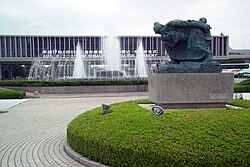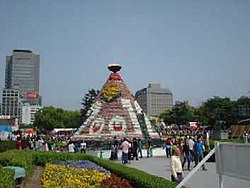Hiroshima Peace Memorial Park
Hiroshima Peace Memorial Park (広島平和記念公園 Hiroshima heiwa kinen kōen) is a memorial park in the center of
Hiroshima, Japan. It is dedicated to the legacy of Hiroshima as the first city in the world to suffer a nuclear attack, and to
the memories of the bomb's direct and indirect victims (of whom there may have been as many as 140,000).
The location of Hiroshima Peace Memorial Park was once the city’s busiest downtown commercial and residential district.
The park was built on open field that was created by the explosion. Today there are a number of memorials and
monuments, museums, and lecture halls, which draw over a million visitors annually. The annual 6 August
Peace Memorial Ceremony, which is sponsored by the city of Hiroshima, is also held in the park.The purpose of the Peace
Memorial Park is to not only memorialize the victims, but also to establish the memory of nuclear horrors and advocate
world peace.
The A-Bomb Dome is the skeletal ruins of the former Industrial Promotion Hall. It is the building closest to the hypocenter of the nuclear bomb that remained at least partially standing. It was left how it was after the bombing in memory of the casualties. The A-Bomb Dome, to which a sense of sacredness and transcendence has been attributed, is situated in a distant ceremonial view that is visible from the Peace Memorial Park’s central cenotaph. It is an officially designated site of memory for the nation’s and humanity’s collectively shared heritage of catastrophe. The A-Bomb Dome is on the UNESCO World Heritage List.
Children's Peace Monument
The Children's Peace Monument is a statue dedicated to the memory of the children who died as a result of the bombing. The statue is of a girl with outstretched arms with a folded paper crane rising above her. The statue is based on the true story of Sadako Sasaki (佐々木禎子 Sasaki Sadako), a young girl who died from radiation from the bomb. She believed that if she folded 1,000 paper cranes she would be cured. To this day, people (mostly children) from around the world fold cranes and send them to Hiroshima where they are placed near the statue. The statue has a continuously replenished collection of folded cranes nearby.
Rest House
The Rest House of Hiroshima Peace Park is another atomic bombed building in the park. The building was built as the Taishoya KimonoShop in March 1929. It was used as a fuel distribution station since the shortage of fuel began in June 1944. On August 6, 1945, when the bomb exploded, the roof was crushed, the interior destroyed, and everything consumable burned except in the basement. Eventually, 36 people in the building died of the bombing; 47-year-old Eizo Nomura survived in the basement, which had a concrete roof through which radiation had a more difficult time penetrating. He survived into his 80s.Ceremonies
Hiroshima Peace Memorial Ceremony
Every year on 6 August, "A-bomb Day," the City of Hiroshima holds the Hiroshima Peace Memorial Ceremony to console the victims of the atomic bombs and to pray for the realization of lasting world peace. The ceremony is held in the morning from 8:00, in front of the Memorial Cenotaph with many citizens including the families of the deceased. During the ceremony, A one-minute silence is observed at 8:15 for the victims, at the time of the atomic bomb's explosion.
Lantern Ceremony
And in the evening of the same day, Lantern ceremony is held to send off the spirits of the victims on lanterns with peace messages floating on the waters of the Motoyasu River.Museums
Hiroshima Peace Memorial Museum
The Hiroshima Peace Memorial Museum is the primary museum in the park dedicated to educating visitors about the bomb. The Museum has exhibits and information covering the build up to war, the role of Hiroshima in the war up to the bombing, and extensive information on the bombing and its effects, along with substantial memorabilia and pictures from the bombing. The building also has views of the Memorial Cenotaph, Peace Flame, and A-Bomb Dome.
International Conference Center Hiroshima
International Conference Center Hiroshima is in the Peace Park, west side of the main building of the Hiroshima Peace Memorial Museum.Hiroshima National Peace Memorial Hall
The Hiroshima National Peace Memorial Hall for the Atomic Bomb Victims is an effort by the Japanese national government to remember and mourn the sacred sacrifice of the atomic bomb victims. It is also an expression of Japan's desire for genuine and lasting peace. The Hall contains a number of displays. On the roof, near the entrance (the museum is underground) is a clock frozen at 8:15, the time the bomb went off. The museum contains a seminar room, library, temporary exhibition area, and victims' information area. Additionally, one of the more stunning areas is The Hall of Remembrance, which contains a 360 degree panorama of the destroyed Hiroshima recreated using 140,000 tiles — the number of people estimated to have died from the bomb by the end of 1945.
Memorial Cenotaph
Near the center of the park is a concrete, saddle-shaped monument that covers a cenotaph holding the names of all of the people killed by the bomb. The monument is aligned to frame the Peace Flame and the A-Bomb Dome. The Memorial Cenotaph was one of the first memorial monuments built on open field on August 6, 1952. The arch shape represents a shelter for the souls of the victims.
The cenotaph carries the epitaph "安らかに眠って下さい 過ちは 繰返しませぬから", which means "please rest in peace, for [we/they] shall not repeat the error." In Japanese, the sentence's subject is omitted, thus it could be interpreted as either "[we] shall not repeat the error" or as "[they] shall not repeat the error". This was intended to memorialize the victims of Hiroshima without politicizing the issue, taking advantage of the fact that polite Japanese speech typically demands lexical ambiguity in the first place. The epitaph was written by Tadayoshi Saika, Professor of English Literature at Hiroshima University. He also provided the English translation, "Let all the souls here rest in peace for we shall not repeat the evil." On November 3, 1983, an explanation plaque in English was added in order to convey Professor Saika's intent that "we" refers to "all humanity", not specifically the Japanese or Americans, and that the "error" is the "evil of war":
- The inscription on the front panel offers a prayer for the peaceful repose of the victims and a pledge on behalf of all humanity never to repeat the evil of war. It expresses the spirit of Hiroshima — enduring grief, transcending hatred, pursuing harmony and prosperity for all, and yearning for genuine, lasting world peace.
Perhaps unsurprisingly, the ambiguity of the phrase has the potential to offend; some right-wing circles in Japan have interpreted the words as an admission of guilt—implicitly reading it as "we shall not repeat the error"—and they criticize the epitaph as a self-accusation by the Japanese empire. In July 2005, the cenotaph was vandalized by a 27 year old Japanese affiliated with the Japanese right.
Peace Flame
The Peace Flame is another monument to the victims of the bomb that destroyed Hiroshima, but it has an additional symbolic purpose. The flame has burned continuously since it was lit in 1964, and will remain lit until all nuclear bombs on the planet are destroyed and the planet is free from the threat of nuclear annihilation.Peace Bells
Atomic Bomb Memorial Mound
Cenotaph for Korean Victims
Among the 400,000 people who were killed or exposed to lethal post-explosion radiation, at least 45,000 were Korean, but the number is uncertain, because the population has been neglected as the minority. Additionally, 300,000 survivors of Hiroshima and Nagasaki returned to Korea after liberation from the Japanese colonialism. The monument, beautified with Korean national symbols, is intended to honour Korean victims and survivors of the atomic bomb and Japanese colonialism. The monument's inscription reads "The Monument in Memory of the Korean Victims of the A[tomic]-Bomb. In memory of the souls of His Highness Prince Yi Wu and over 20000 other souls", while the side-inscription reads "Souls of the dead ride to heaven on the backs of turtles."The Gates of Peace
Other Monuments[edit]
- Pond of Peace - encircling the Cenotaph to show its on the water
- Peace Clock Tower
- A-bombed Gravestone - gravestone of Jisenji temple - the temple used be there
- Peace Fountain
- Monument to the Old Aioi Bridge
- Phoenix Trees Exposed to the A-bomb - also known as Chinese Parasols, these trees have deep scars from the blast. They were moved here from the courtyard of the former Hiroshima Post & Telecommunications Office in 1973.[20]
- Linden Tree Monument
- Hair Monument
- Hiroshima City Zero Milestone
- Peace Cairn
- Stone Lantern of Peace
- Friendship Monument
- Peace Memorial Post
- Peace Tower
- Fountain of Prayer - there was a small fountain pond
- Monument of Prayer
- Prayer Monument for Peace
- Prayer Haiku Monument for Peace
- Hiroshima Monument for the A-bomb Victims
- Statue of Mother and Child in the Storm
- Peace Watch Tower - indicating the number of days since the A-bomb
- Statue of Peace "New Leaves" - from the words of Dr.Hideki Yukawa - designed, carved by Katsuzo Entsuba
- Statue of Merciful Mother
- Statue of a Prayer for Peace
- The Figure of the Merciful Goddess of Peace (Kannon)
- Mobilized Students' Merciful Kannon Monument
- Memorial Tower to the Mobilized Students
- Hiroshima Second Middle School A-bomb Memorial Monument
- Memorial Monument of the Hiroshima Municipal Commercial and Shipbuilding Industry Schools
- Monument to the A-bombed Teachers and Students of National Elementary Schools
- A-bomb Monument of the Hiroshima Municipal Girl's High School
- Monument Dedicated to Sankichi Tōge
- Monument to Tamiki Hara
- Literary Monument Dedicated to Miekichi Suzuki
- Monument in Memory of Dr.Marcel Junod
- Clock Commemorating the Repatriation of Those Who Chose to Return to the Democratic People's Republic of Korea
- Monument of the Former North Tenjin-cho Area
- Monument of the Former South Tenjin-cho Area
- Monument of the Former Zaimoku-cho
- Memorial Tower for A-bomb-related Victims
- Memorial Tower to Console A-bomb Victims
- Monument in Memory of the Korean Victims of the A-bomb
- Monument of the Volunteer Army Corps
- Monument of "Zensonpo"(All Japan Nonlife Insurance Labor Union)
- Monument to Those Who Died From the Chūgoku-Shikoku Public Works Office
- Monument of the Hiroshima District Lumber Control Corporation
- Monument Dedicated to Construction Workers and Artisans
- Monument to the Employees of the Hiroshima Post Office
- Monument of the Hiroshima Gas Corporation
- Monument to the Employees of the Coal Control-related Company
- Monument for the A-bomb Victims from the Hiroshima Agricultural Association
- Monument to Mr. Norman Cousins
- Monument of US POWS {at former Chugoku MP HQ [21]}
Main article: Hiroshima Flower Festival
Hiroshima Flower Festival is held from 3rd to 5 May, during Japanese Golden Week, in the Peace Park and Peace Boulevard.



































































































































No comments:
Post a Comment